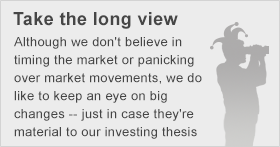
What: The end of 2015 couldn't come fast enough for GrubHub Inc. (GRUB +0.00%) shareholders. According to data from S&P Capital IQ, shares of the food delivery specialist delivered a rather stomach-troubling return last year, falling 32.7%.
So what: GrubHub shares flew out of the IPO gate in 2014 with investors willing to pay lofty multiples for the company's juicy 35% operating margin and 3 million-plus "Active Diners." Of course, the problem with high-flying growth stocks is that Mr. Market's punishment is all the more severe when expectations aren't met, and in 2015, GrubHub shareholders felt this wrath firsthand.
On Oct. 27, for example, the shares plummeted a whopping 24% after the company's Q3 results missed estimates. In that report, GrubHub posted year-over-year revenue growth of 38%, solid by most standards, but it was substantially lower than the roughly 50% top-line increases it saw in prior quarters. That significant revenue deceleration, coupled with a spike in costs, triggered plenty of concerns on Wall Street about rapidly increasing competition and the prospect of compressing margins heading into 2016.
Now what: GrubHub expects to post Q4 EBITDA in the range of $23 million to $25 million on revenue of $98 million to $100 million, suggesting that growth will continue to decelerate at least in the near term. "While delivery volume remains low relative to overall volume on GrubHub, we've seen tangible improvements in diner frequency, order growth and conversion in some of our secondary markets where restaurants we deliver for generate a significant amount of the overall order volume," said CEO Matt Maloney last quarter. "This gives us confidence that our investment in delivery will reap rewards across our entire network over time." When you couple GrubHub's significantly slowing operating momentum with its still-lofty forward P/E of 30, however, I'd wait for an even wider margin of safety before buying into that optimism.






